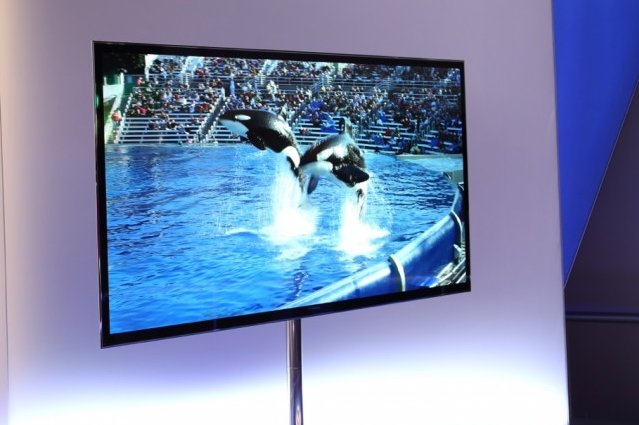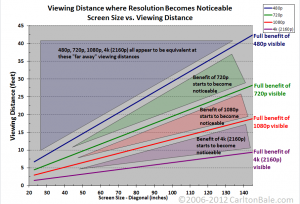
The four-day orgy of technology-enabled consumerism that is the Consumer Electronics Show has come to a close. One of the wow-inducing technologies on display was Ultra HD—televisions that offer stunning 2160p (3840×2160) resolutions as well as 4320p, which puts us in IMAX territory. All of the major television manufacturers were showing off Ultra HD sets in hopes that consumers will ready their credit cards for an upgrade.
I think those hopes are in vain. And it's not just because Ultra HD sets are insanely expensive, although that's a significant reason. The prices on some of the TVs that were shown off were just as jaw-dropping as the specs. Assuming you had space for an 84" Ultra HD TV, you'd need to cough up $20,000 for the privilege of owning it.
There will be "value priced" Ultra HD sets, of course. Westinghouse will have a lineup of eight sets out in 2013 starting with a 50" model priced at $2,500 and a 55" model for $3,000. That's comparable to where 1080p prices were in 2008, and they'll no doubt drop. But that low-end Ultra HD set still costs five times what a budget 50" 1080p model runs at an outlet like Amazon.
Whether you're going big or small, you'll pay a hefty premium for those extra pixels. The cost will mean the only ones going for Ultra HD sets will be early adopters with deep pockets, at least for the first couple of years.
Even when prices drop, however, most consumers are likely to stand on the sidelines. How many of you have purchased HDTVs in the past four or five years? I've bought three: a 32" 720p set for the bedroom, a 40" LCD in the family room, and a 58" plasma set for the mancave. How anxious are you to upgrade? I'm not. Those televisions represent a significant outlay of cash for me, especially given that my 40" 1080p set was purchased in the fall of 2007. I don't think most people are going to be inclined to walk away from their investments in HDTV just because there's something better-looking in the pipeline, at least as long as their HDTVs are working.

There are also legitimate doubts that many people will even be able to appreciate the full beauty of an Ultra HD image. If you're standing 10 feet away from an 84" Ultra HD TV at CES, you'll no doubt see the difference in image quality. But think about your living room, or whatever place in your house you do your TV watching. Will you actually be seated close enough to the TV to truly appreciate the difference?
A home theater enthusiast worked up some charts showing the distances at which viewers need to sit in order to get the full benefit of the higher resolution. They're really concerned with the difference between 720p and 1080p, but 2160p is included as well. Looking at the chart, you can see that if you're rocking a 50" Ultra HD set, you'll need to be sitting pretty close in order to get the full benefit of the increased resolution. And if you're sitting much more than seven feet away, you're going to have a tough time seeing the difference between Ultra HD and 1080p.
Given TV sizes and room dimensions, 1080p HD content is going to be good enough for most people. There will always be people who want the best possible picture, but for a large segment of the HDTV-owning public, 1080p (or even 1080i) is HD enough—especially when faced with the cost of buying a new set. I've got the Lord of the Rings extended version on 480p DVD and it looks really fantastic on my 58" plasma display. The current generation of game consoles can't handle resolutions higher than 1080p, and upscaled games aren't going to look too hot an a 2160p set.
There's also a scarcity of Ultra HD content to watch, and that's unlikely to change in the anytime soon. Yes, there are a couple of Ultra HD players available, like the one from RED we reported on. Sony also has a 4K download service in the works. There will no doubt be more coming down the pike, as well. But optical media is on the downswing, so unlike 1080p, which had Blu-ray and HD DVD launching alongside it, there's no corresponding format push from consumer electronics manufacturers.
Consumers who do opt for Ultra HD and buy a REDRAY player or subscribe to Sony's service are going to be faced with another uncomfortable reality: bandwidth caps. As noted in our piece on RED, those Ultra HD movies are huge—a single 100-minute flick will eat up about 15GB of your ISP's monthly data allotment. That's several times the size of a 1080p download from Netflix or the iTunes Store.
Ultra HD content is going to be difficult to find outside of download services, as well. Cable and satellite TV providers currently have to pick and choose which networks they offer in HD due to bandwidth constraints. If you take the 20Mbps data rate for RED's Ultra HD files as a guideline, there's just not enough infrastructure for TV providers to deliver Ultra HD. Getting the data rate down lower will require additional compression, and when you start compressing content, you lose one of the key selling points of the higher-definition format. The pipes just aren't phat enough for Ultra HD programming right now, and that looks unlikely to change in the near term.
A couple of years ago, 3D was all the rage at CES. There's some content available—3D movies, 3D games, and even a smattering of 3D broadcasts. But people haven't been lining up to buy TVs just for the 3D experience. Last April, Samsung said that sales of 3D TVs were just 30 percent of what the industry had expected. Sales of TVs with some 3D capability are on the rise, but that is not driving sales—3D is often just another item on the feature list.
That doesn't bode well for Ultra HD adoption over the next few years. The new format will be heavily hyped, but a buying public that has purchased HDTVs in the past few years will agree that yes, it's an utterly fantastic picture, and then go back to happily watching movies, sports, and reality TV in 1080p.
reader comments
168